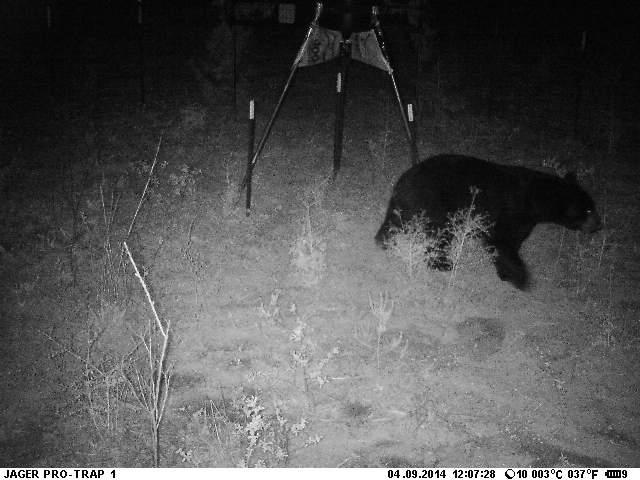
by Rick O'Connor | Nov 10, 2025
Over the last decade human-bear encounters have increased across Florida, including the Panhandle. Recently the Florida Fish and Wildlife Conservation Commission (FWC) posted advice on how we can prepare for the fall season.

Florida Black Bear visiting an easy food source.
They mention that fall is a time when bears begin seeking additional food sources to prepare for winter. An adult bear can consume up to 20,000 calories a day during this prep period. All creatures will seek the easiest source of food, reducing energy effort in capturing, and will take the opportunity to raid garbage cans, pet food left outside, and even bird feeders. Here are tips FWC suggests.
- Never Feed Bears. Doing so will reduce their natural fear of humans, and intentionally doing so is illegal in Florida.
- Secure Food and Garbage. Some suggestions on how to do this…
- Keep your trash can in a sturdy shed or garage and do not place on the street until morning.
- Modify your trash can to make it more secure. Tips for this can be found from FWC at Instructions on Making a Trashcan Bear-Resistant.
- Purchase a bear resistant trash can. Bear Resistant Trash Containers.
- They are attracted to gardens, compost piles, beehives, and livestock. Take measures to reduce their ability to reach these.
- Pick ripe from fruit trees and remove fallen fruit from the ground.
- Remove, or secure, bird feeders. If you want to feed winter birds, place only enough food for the delay and remove it at night. You can find other suggestions to help winter birds at this site – Attract Backyard Birds, Not Backyard Bears – BearWise.
- Never leave pet food outdoors. This is actually a good suggestion to reduce raccoon, coyote, and other wildlife encounters. If you must feed your pet outside, do so for only short periods and bring all food after dark.
- Clean and store grills.
- Alert neighbors to bear activities. Share these tips with them and your HOA.
Bears are generally afraid of humans and are not aggressive but can become so when there are mothers protecting cubs, and dogs. 60% of all human-bear encounters involved dogs. When walking your dogs keep them on a short leash and be aware of your surroundings and your dog’s reaction to your surroundings. Before letting your dog out at night turn the exterior lights on and off several times and bang the door. Keep in mind they will be moving more this time of year and are most often encountered on the roads at dawn and dusk.
If you have further questions, or need further information, search the FWC website.
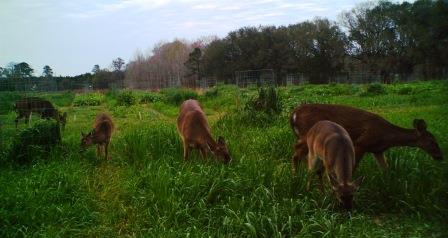
by Mark Mauldin | Aug 4, 2025

Deer grazing test plots at the NFREC in Quincy. Quality food plots take effort and planning.
The during the blistering heat of the last week of a Florida July is generally not a time when people think a lot about planting crops, but maybe it should be. Late summer can be a surprisingly active time in the world of wildlife food plots.
For those land managers who already have well established food plots, this time frame represents the end of the window for planting summer annual forages. Of the summer annuals that are particularly appealing to deer, cowpeas standout as the best option for late summer plantings. There are also several grass crops that can be planted late summer in food plots focusing on birds. While earlier plantings allow crops time to grow before pest and disease pressure peak in late summer, they also mean the crops will have matured and stopped growing before hunting season begins. Late planted forages may face some challenges and likely will not be the most beautiful crops you have ever grown but they will still be growing when archery season begins. Cowpeas take approximately 100 days to mature; this means that most years August 1st plantings will have time to mature before being killed by frost. Even if we get an early (mid-October) frost the cowpeas will have provided high quality forage right up to the beginning of archery season (October 25 in the Panhandle).
For those who are looking to establish new food plots or those whose past management may have been somewhat lacking, late summer is really when the process of preparing cool-season food plots needs to begin.
Finding the Right Spot Can Take A While
For the creation of a new food plot identifying the location is the first step. Edges, transitions between habitat types, are often a good place to start looking. Utilizing locations where deer (or whatever wildlife you are focusing on) already frequent is preferential to the “if I build it, they will” come mindset. Additional factors that cannot be overlooked are the drainage and workability of any potential site. Suitable planting options for both poorly (stands water, even occasionally) and excessively drained (deep sands) sites will be severely limited. Sites with drainage issues often have less natural vegetation making them appealing for use as a food plot since less clearing is needed. However, these sites generally do not work out well. Don’t forget, successful food plot establishment and maintenance necessitates easy access with farm equipment and ground level enough to safely operate said equipment.
A final consideration when identifying possible food plot locations is the amount of space available to work with. When it comes to food plots, size really does matter. Food plots need to be no less than ½ acre in size, preferably between 1 and 5 acres. The kinds of plants in food plots are, by design, ones that wildlife find highly desirable (because they are highly nutritious). Considering this, it is easy to understand why plantings smaller than ½ acre struggle to establish – the plants simply do not get a chance grow past the seedling stage before being eaten. Given all these considerations, finding the right spot really can take a while – get started soon because selecting the spot is just the first step.
Start Early with Pre-Plant Land Prep
After a location is identified, it is crucial to manage unwanted vegetation prior to preparing the soil and planting the food plot. If it is not eliminated, existing vegetation will compete tremendously with food plot plantings. Even if mechanical disturbance (disking, tilling, root raking, etc.) appears to remove the existing vegetation, much of it will regrow. This regrowth from established root systems will be more than a match for new seedlings. Apply herbicide before you begin soil preparation. Equally as important, give the herbicide sufficient time to do its work before mechanically disturbing the site (weeks, not days). Specific herbicide recommendations will vary depending on what vegetation you are trying to manage, but most food plot site prep applications will involve fairly high rates of glyphosate. Please don’t hesitate to call me (850-638-6180) – we can discuss your site and dial in an herbicide recommendation. You do not want to skip this step; get in front of weed pressure before you plant.
If you want a food plot to be productive and successful, you must also effectively address soil fertility issues prior to planting. First and foremost, soil pH must be corrected. Any needed applications of lime/dolomite need to take place first, well before any other fertilizer is applied (ag lime can take months to go into soil solution and alter soil pH). If fertilizers are applied before the soil pH is corrected the nutrients may still be unavailable to the plants. Once a food plot site is determined, collect a representative sample of the rooting zone soil and submit it to a lab for analysis. This is the best way to get the information needed to make informed choices regarding lime and fertilizer applications. Talk with the folks at your local Extension Office for more info on how to collect and submit soil samples. Take and submit soil samples now. Apply any need lime soon, during land preparation. Apply recommended fertilizer (N, P, K, and micros) at planting or soon after emergence. Fertilizer applied when there are no plant roots present to adsorb it is wasted.
Recap – Assuming the goal is to plant a cool-season food plot prior to the beginning of hunting season you need to pick and clear a spot, kill weeds, and soil sample very soon. After weeds have had time to die (30 days +/-), apply any needed lime/dolomite and till/disc under dead weeds and lime.
Ideally, you’d get all this done several weeks before the fall planting window (10/1-11/15) gets here. In that event, let the plot rest; let the tilled soil settle and rain-pack and let the next flush of weeds germinate. Many of our fall planted food plot crops, clovers in particular, do better when planted into a very firm seed bed making the resting period very beneficial. Additionally, another herbicide application, to take out the most recent flush of weeds, can be made at planting time ensuring your plot gets started clean and free from competition.
I know it’s hot, but as a land manager there is always something to do. Fall will be here before you know it, and now is the time to start getting ready.
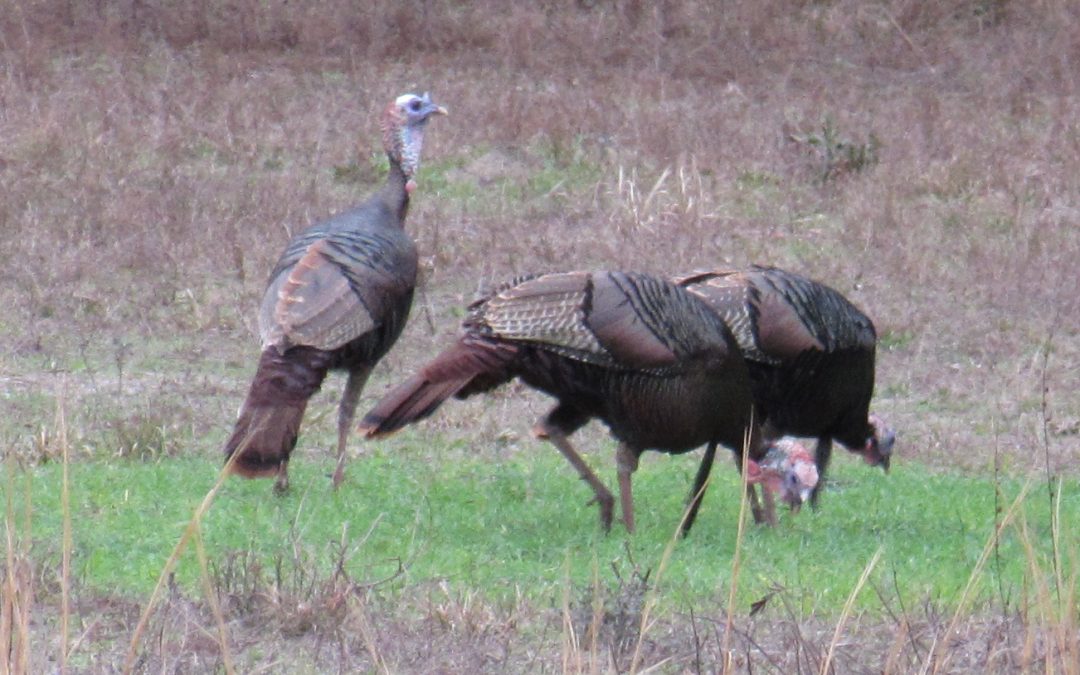
by Jennifer Bearden | Jan 31, 2025
Before you know it spring turkey season will be upon us and now is the time to start planning a killer turkey food plot. Establishing a great food plot takes more than just planting seeds. It takes planning and preparation prior to planting those seeds. The prime turkey food plot is chufas. Chufas are yellow nutsedges that turkeys absolutely love.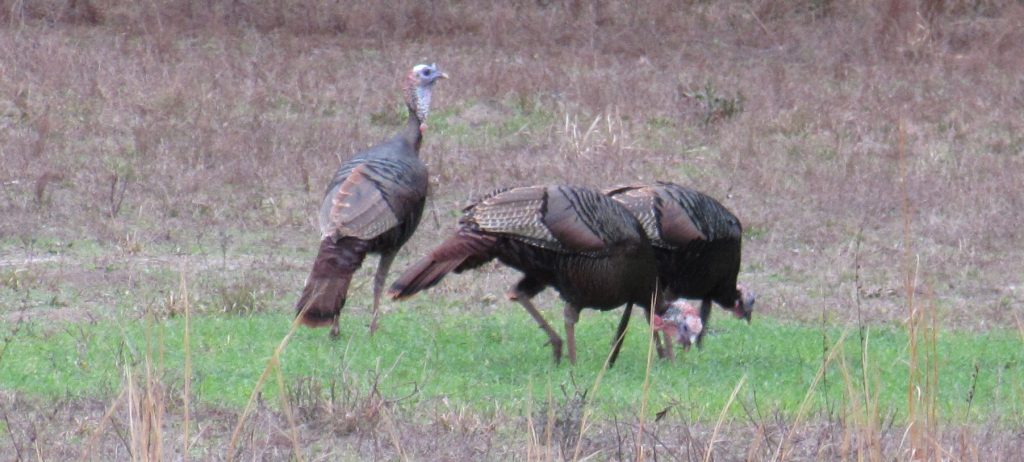
The first step is finding a good spot. A 20ft x 20ft spot with no trees and ample sunlight will work well. You can select a larger spot but that increases the cost of planting. Chufas prefer full sunlight so make sure the area gets 6-8 hours of sunlight per day.
Next step is to take a soil sample from the area. Here’s a video demonstrating how to properly take a soil sample. When you get your soil sample results back, you will want to adjust the pH as necessary. Perform this task well ahead of planting to give the lime time to raise the pH. Chufas grow best with the soil pH between 6.0-7.0.
Now other animals love chufas too, like hogs and rabbits. I wouldn’t plant chufas if you know you have a large population of rabbits or you have a feral hog problem. Reduce those populations before planting chufas.
Other options include plants such as brown top millet and buckwheat. Turkeys love tender young shoots. You can plant these in March ahead of spring turkey season. These plots also will attract insects which the turkeys feed on.
Now we get to the fun part – planting. Chufas can be planted anytime between April and July. They germinate quickly once soil temperatures are above 65º F.. You can plow the area or use a herbicide like glyphosate to kill existing vegetation. For chufas, you can use a pre-emergent herbicide like trifluralin or pendimethalin to help suppress weeds during the growing season.
| Plant |
Broadcast Seeding Rate |
| Chufas |
40-50lb/acre |
| Brown top millet |
20-25lb/acre |
| Buckwheat |
50- 55lb/acre |
I find that packing the soil after broadcasting the seed, either by driving over it or by using a cultipacker, helps with germination as the seeds flourish with a firm seed bed.
Next, fertilize according to your soil test results and enjoy a great spring turkey season.

by Ray Bodrey | Nov 21, 2024
Recently Jennifer Bearden, our Agriculture & Natural Resource Agent in Okaloosa County wrote a great article on “Common Wildlife Food Plot Mistakes”. The following information is a mere supplement in establishing food plots. Planting wildlife forages has become a great interest in the Panhandle. North Florida does have its challenges with sandy soils and seasonal patterns of lengthy drought and heavy rainfall. With that said, varieties developed and adapted for our growing conditions are recommended. Forage blends are greatly suggested to increase longevity and sustainability of crops that will provide nutrition for many different species.

Hairy Vetch – Ray Bodrey
In order to be successful and have productive wildlife plots. It is recommended that you have your plot’s soil tested and apply fertilizer and lime according to soil test recommendations. Being six weeks from optimal planting, there’s no time like the present.
Below are some suggested cool season wildlife forage crops from UF/IFAS Extension. Please see the UF/IFAS EDIS publication, “A Walk on the Wild Side: 2024 Cool-Season Forage Recommendations for Wildlife Food Plots in North Florida” for specific varieties, blends and planting information. https://edis.ifas.ufl.edu/pdffiles/AG/AG13900.pdf
Winter legumes are more productive and dependable in the heavier clay soils of northwest Florida or in sandy soils that are underlain by a clay layer than in deep upland sands or sandy flatwoods. Over seeded white clover and ryegrass can grow successfully on certain flatwoods areas in northeast Florida. Alfalfa, clovers, vetch and winter pea are options of winter legumes.
Cool-season grasses generally include ryegrass and the small grains: wheat, oats, rye, and triticale (a human-made cross of wheat and rye). These grasses provide excellent winter forage and a spring seed crop which wildlife readily utilize
Brassica and forage chicory are annual crops that are highly productive and digestible and can provide forage as quickly as 40 days after seeding, depending on the species. Forage brassica crops such as turnip, swede, rape, kale and radish can be both fall- and spring-seeded. Little is known about the adaptability of forage brassicas to Florida or their acceptability as a food source for wildlife.

Deer taking advantage of a well maintained food plot. Photo: Mark Mauldin
For more information, contact your local county extension office.
UF/IFAS Extension is an Equal Opportunity Institution.
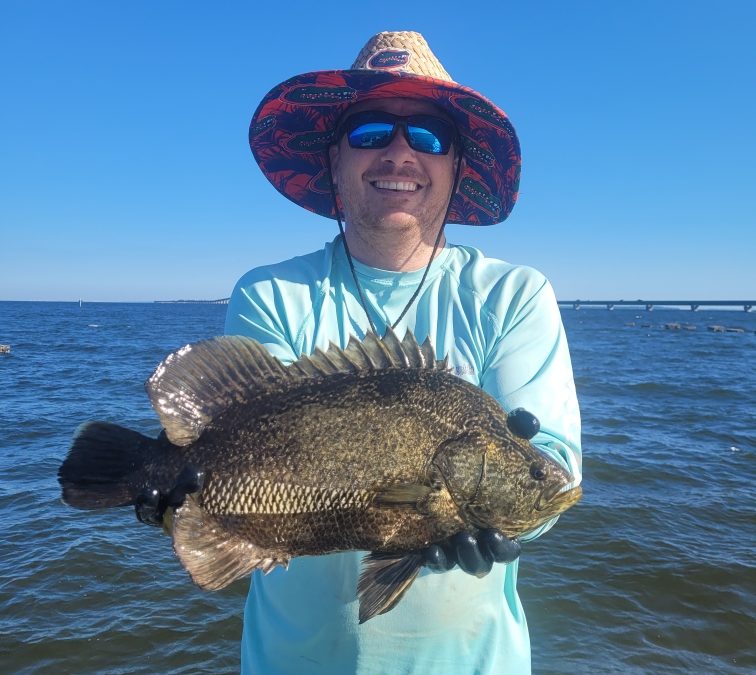
by Thomas Derbes II | Nov 8, 2024
The Atlantic Tripletail (Lobotes surinamensis) is a very prized sportfish along the Florida Panhandle. Typically caught as a “bonus” fish found along floating debris, the tripletail is a hard fighting fish and excellent table fare. Just as the name implies, this fish is equipped with three “tails” that help aid it in propulsion; and also help contribute to their strong fighting spirit. In addition to the caudal fin, tripletail have very pronounced “lobed” dorsal and anal fin soft rays that sit very far back on the body, giving it the appearance of three tails (triple-tails).

Atlantic Tripletail (Lobotes surinamensis) – FWC, Diane Rome Peebles 1992
Tripletail are found in tropical and subtropical seas around the world (except the eastern Pacific Ocean) and are the only member of their family found in the Gulf of Mexico. Tripletail can be found in all saltwater environments, from the upper bays to the middle of the Gulf of Mexico. In the Florida Panhandle, tripletail begin to show up in the bays beginning in May and can be found up until October/November. They are masters of disguise, usually found floating along floating debris, crab trap buoys, navigation pilings, and floating algae like Sargassum. When tripletail are young, they are able to change their colors to match the debris, albeit it is usually a variation of yellow, brown, and black. Adult tripletail can change color as well, but the coloration is not as vibrant as the juveniles. Floating alongside debris and other floating materials protects them from predators and gives them food access. Small crustaceans, like shrimp and crabs, and small fish will gather along the floating debris, looking for protection, giving the camouflaged tripletail an easy meal.
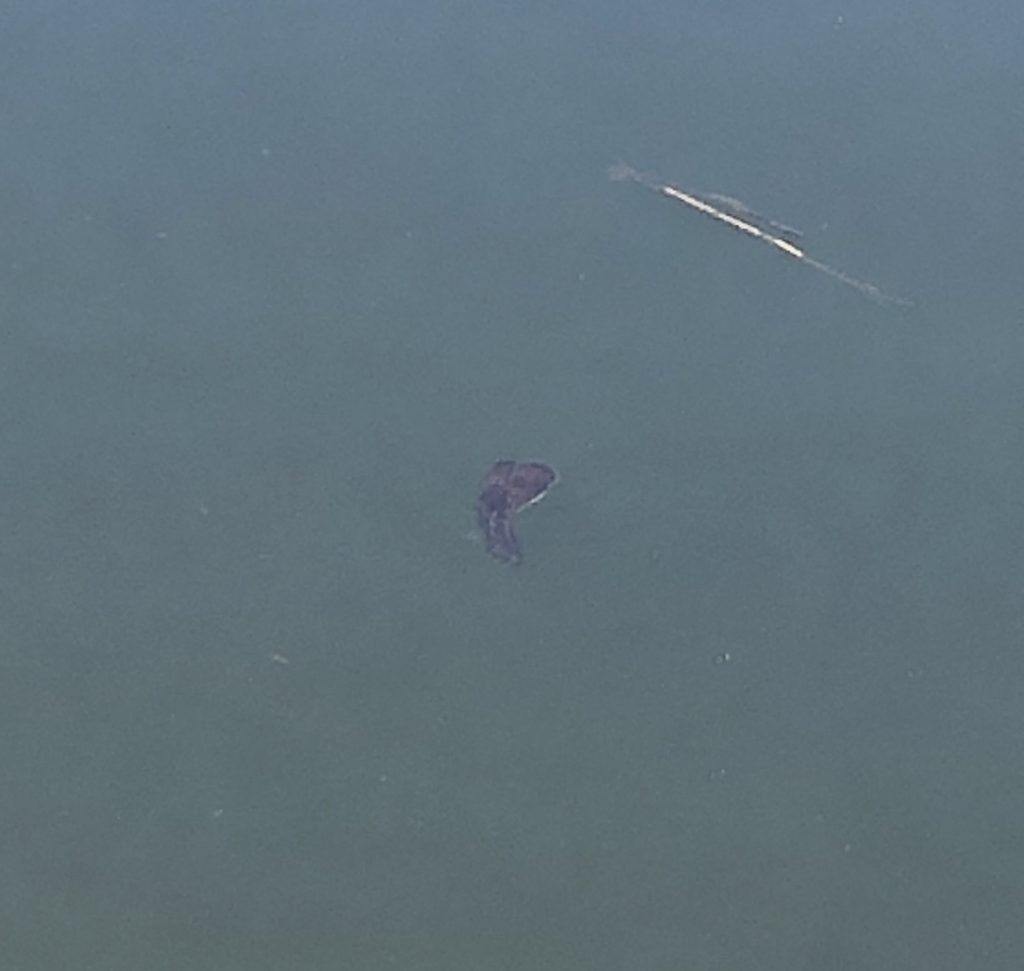
Baby Tripletail or Leaf? – Thomas Derbes II
Tripletail are opportunistic feeders that are what I classify as “lazy hunters.” Tripletail will hang out along any floating debris and wait for the food to come to them. They typically will not chase their prey items too far and will abandon the hunt if they expend too much energy. Since they are opportunistic feeders, their diet varies widely, but they cannot resist a baby blue crab, shrimp, or small baitfish like menhaden (Brevoortia patronus) that might visit their floating oasis. When further offshore, it is not uncommon to find many tripletail “laying out” on sargassum or floating debris. I personally have seen a dozen full-sized tripletail inside of a large traffic barrel 25 miles offshore that saved a skunk of a deep-dropping fishing trip.
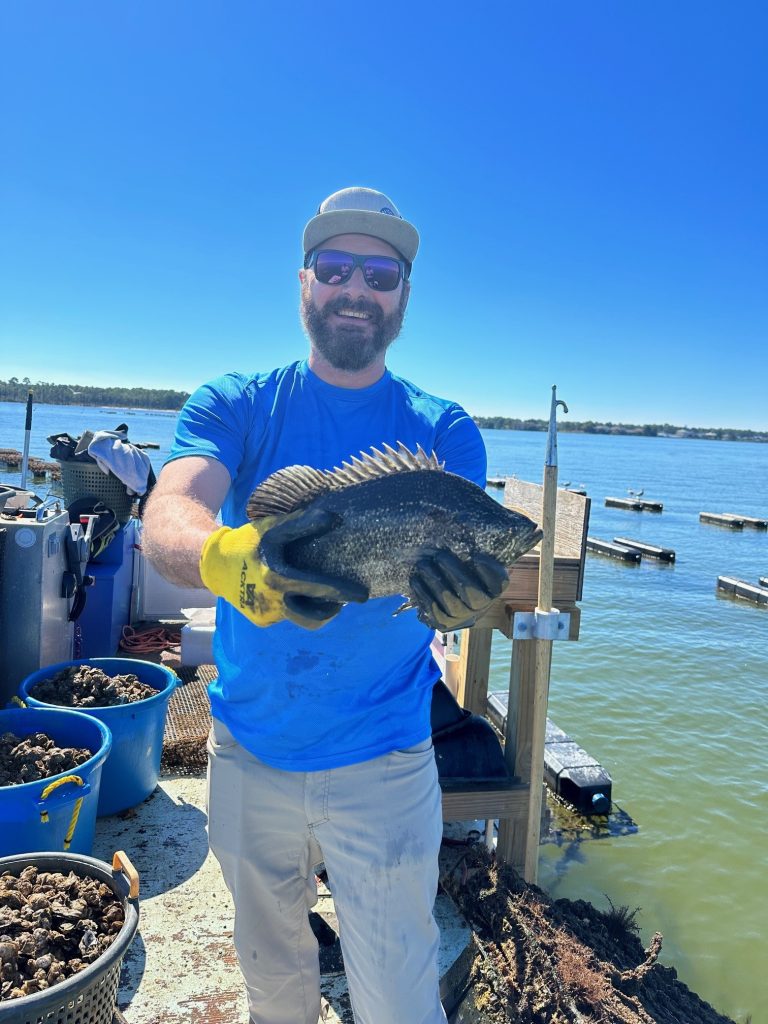
Tripletail Caught Off An Oyster Farm – Brandon Smith
When targeting tripletail, anglers will typically sit at the highest point of the boat (some anglers have towers for spotting tripletail) and cruise along floating crab trap buoys, pilings, and sometimes oyster farms looking for Tripletail. These fish are very easily spooked, and a slow, quiet approach is best. Once in casting distance, toss your preferred bait (I typically want to have baby crabs or live shrimp when targeting tripletail) close to the floating structure, but not too close to spook the fish. You can usually watch the fish eat your bait (another added bonus) and once you set the hook, the fight is on! In the state of Florida, tripletail must be a minimum of 18 inches and there is a daily bag limit of 2 fish per person. Be very careful handling tripletail as they have very sharp dorsal and anal fins and their operculum (gill cover) is also very sharp with hidden spines.
So next time you’re out fishing and see something floating, make sure you give it a good look over. There might be a camouflaged tripletail that you can add to your fish box!
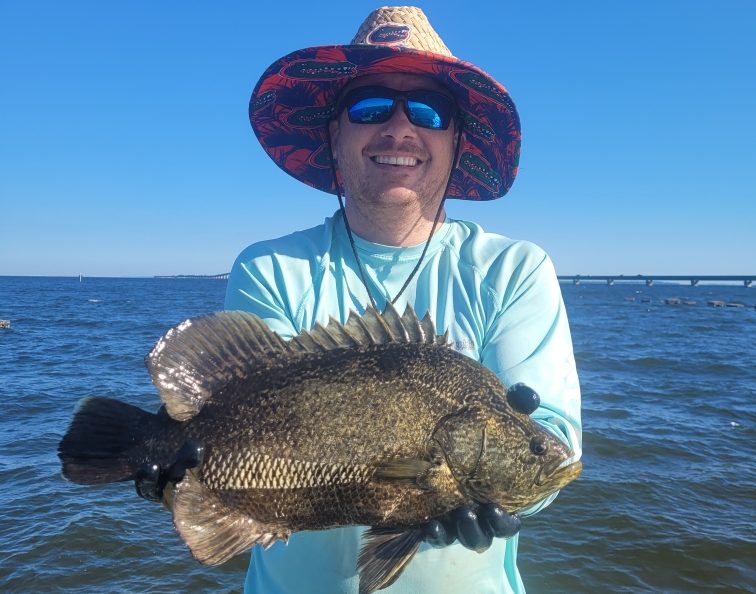
Tripletail Caught While Working Oyster Gear – Thomas Derbes
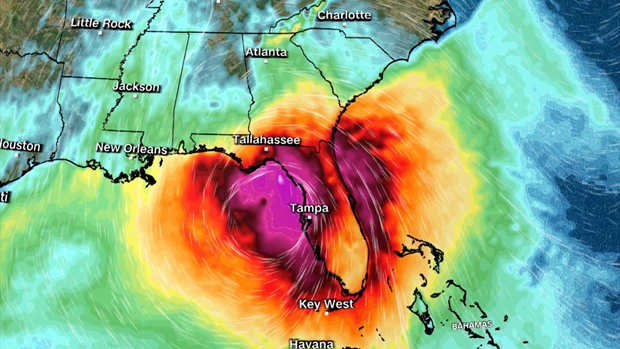
by Sheila Dunning | Oct 4, 2024
Coastal wetlands are some of the most ecologically productive environments on Earth. They support diverse plant and animal species, provide essential ecosystem services such as stormwater filtration, and act as buffers against storms. As Helene showed the Big Bend area, storm surge is devastating to these delicate ecosystems.

Hurricane Track on Wednesday evening.
As the force of rushing water erodes soil, uproots vegetation, and reshapes the landscape, critical habitats for wildlife, in and out of the water, is lost, sometimes, forever. Saltwater is forced into the freshwater wetlands. Many plants and aquatic animal species are not adapted to high salinity, and will die off. The ecosystem’s species composition can completely change in just a few short hours.
Prolonged storm surge can overwhelm even the very salt tolerant species. While wetlands are naturally adept at absorbing excess water, the salinity concentration change can lead to complete changes in soil chemistry, sediment build-up, and water oxygen levels. The biodiversity of plant and animal species will change in favor of marine species, versus freshwater species.
Coastal communities impacted by a hurricane change the view of the landscape for months, or even, years. Construction can replace many of the structures lost. Rebuilding wetlands can take hundreds of years. In the meantime, these developments remain even more vulnerable to the effects of the next storm. Apalachicola and Cedar Key are examples of the impacts of storm surge on coastal wetlands. Helene will do even more damage.
Many of the coastal cities in the Big Bend have been implementing mitigation strategies to reduce the damage. Extension agents throughout the area have utilized integrated approaches that combine natural and engineered solutions. Green Stormwater Infrastructure techniques and Living Shorelines are just two approaches being taken.
So, as we all wish them a speedy recovery, take some time to educate yourself on what could be done in all of our Panhandle coastal communities to protect our fragile wetland ecosystems. For more information go to:
https://ffl.ifas.ufl.edu/media/fflifasufledu/docs/gsi-documents/GSI-Maintenance-Manual.pdf
https://blogs.ifas.ufl.edu/news/2023/11/29/cedar-key-living-shorelines/












